| Columns Retired Columns & Blogs |
Rockport Technologies Merak II loudspeaker & Sheritan II subwoofer Measurements
Sidebar 3: Measurements
For practical reasons, most of the measurements were performed on the Rockport Merak II alone, sitting on its dedicated stand (which carries the crossover). Where measurements include the contribution of the Sheritan II subwoofer, this is indicated in the text.
The Merak's voltage sensitivity was to specification, at an estimated 87dB(B)/2.83V/m, which is the average figure for the 550 or so speakers I have measured in the past 15 years. The speaker's impedance graph (fig.1) reveals a rather lower magnitude in the treble than in the midrange and bass, with a minimum value of 3.2 ohms at 3.2kHz. As well as making the speaker a fairly demanding load for tube amplifiers having a high source impedance, this will result in the speaker's treble shelving down slightly. The saddle centered on 40Hz in the magnitude trace indicates the tuning frequency of the rear-facing port, suggesting fairly modest low-frequency extension.
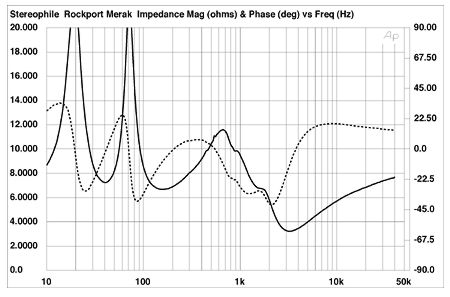
Fig.1 Rockport Merak II, electrical impedance (solid) and phase (dashed). (2 ohms/vertical div.)
Adding the Sheritan II subwoofer, replacing the crossover in the stand with that in the Sheritan, and plugging the Merak's port with the supplied foam ball gave the impedance graphs shown in fig.2. The magnitude in the treble is unchanged, but now the impedance through the midbass to the lower midrange drops below 4 ohms, with a minimum value of 2.7 ohms at 228Hz. With a tube amp, the treble will now be in better balance with the lower frequencies—which is what Michael Fremer heard. The small saddle at 28Hz is the tuning frequency of the Sheritan's port, which, under anechoic conditions, will also be the sub's -6dB point. In a room of typical size, the usual boundary reinforcement will give flat response to 20Hz.
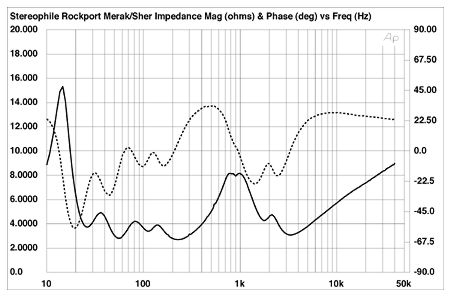
Fig.2 Rockport Merak II/Sheritan II, electrical impedance (solid) and phase (dashed). (2 ohms/vertical div.)
Investigating the vibrational behavior of the Merak's cabinet with an accelerometer revealed that it was as inert as claimed. The only mode I could find was on the side panel above the central seam (fig.3). Not only is this high in frequency, hence subjectively less harmful than the usual, lower-frequency resonances found in enclosures this large, but it is also extremely low in level. A knuckle rap revealed that the Sheritan's MDF cabinet was less inert than the Merak's composite structure. However, investigation with the accelerometer found nothing problematic, presumably because what resonances there are lie above the unit's passband, so will not be excited.
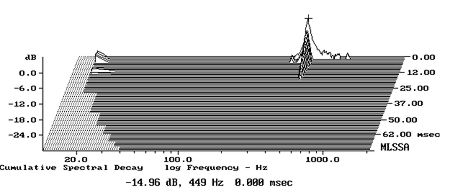
Fig.3 Rockport Merak II, cumulative spectral-decay plot calculated from the output of an accelerometer fastened to the cabinet's side panel (MLS driving voltage to speaker, 7.55V; measurement bandwidth, 2kHz).
Fig.4 investigates the relationship between the Merak and the Sheritan. (All responses in this graph were taken in the nearfield.) The black trace is the Merak's response driven by the Sheritan crossover and with the foam ball in its port. It starts to gently roll off below 200Hz, crossing over to the Sheritan's overall output (blue trace) around 110Hz. (The exact frequency depends very much on the relative plotted levels of the two units; I calculate these based on the ratio of the radiating diameters.) There is a suspicious-looking notch at 800Hz in the Merak's nearfield response. I initially thought this was an interference effect from the very close microphone placement. However, the frequency is too low for this, so it might well indicate some sort of problem at this frequency.
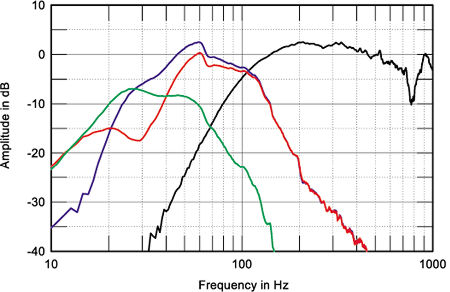
Fig.4 Rockport Merak II/Sheritan II, nearfield responses of Merak woofer with port plugged (black), Sheritan woofer (red), port (green), and the complex sum of the nearfield woofer and port responses (blue).
The Sheritan rolls off smoothly above its passband, though there is a slight bump in its output at 60Hz. This is also evident in the responses of its woofer alone (red) and of its port (green). The Sheritan port's overall peak coincides with the minimum-motion point of its woofer at 28Hz, as expected from fig.2. The alignment seems rather overdamped—a good thing, given the room gain that the Sheritan will experience in the low bass.
From left to right, fig.5 shows the individual responses of the Merak's port, woofer, and tweeter. The woofer's minimum-motion point occurs at 40Hz, as predicted by the impedance plot, but the port's output actually peaks half an octave higher. There is also a second peak evident at around 275Hz, but this is well down in level and will be subjectively innocuous.

Fig.5 Rockport Merak II, acoustic crossover on tweeter axis at 50", corrected for microphone response, with the nearfield responses of the woofer and port plotted below 350Hz and 1kHz, respectively.
Higher in frequency, the woofer does indeed suffer from a small suckout at 800Hz in the farfield. It also peaks up slightly before crossing over to the tweeter just above the specified 2kHz. (The actual crossover point is shown here; there are no calculations involved with these farfield measurements.) The acoustic crossover slopes are close to third-order, 18dB/octave, and the tweeter's on-axis response is basically flat below 11kHz, with a slight rolloff apparent above that frequency.
Fig.6 shows how all this adds up, averaged across a ±15 degrees horizontal window on the tweeter axis. The Merak's top octave rolls off slightly, this due both to the tweeter's inherent response and to its limited dispersion above 10kHz (see later). The mid-high treble is evenly balanced, but the low treble peaks up slightly—due to the woofer behavior noted earlier—as does the middle of the midrange. The trace below 300Hz is the complex sum of the Merak's woofer and port responses. The rise in the upper bass will be mainly due to the nearfield measurement technique, which assumes a half-space acoustic environment for the radiating diaphragms. However, as Mikey found that the Merak on its own sounded rather bass-heavy, perhaps the rise is partly real. Of course, the Wavac amplifiers he first used with the Rockport speakers also boost the bass (see figs.1 and 2, July 2004, p.74); but he also noted the Merak's powerfully balanced midbass when he switched to the flat-response Musical Fidelity kW monoblocks.
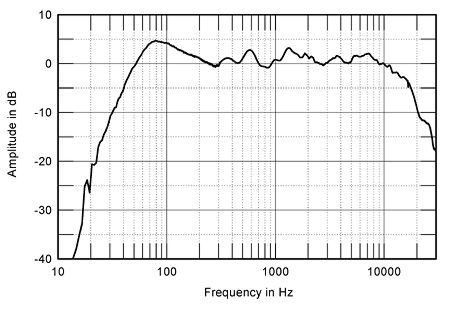
Fig.6 Rockport Merak II, anechoic response on tweeter axis at 50", averaged across 30 degrees horizontal window and corrected for microphone response, with the complex sum of the nearfield woofer and port responses, taking into account acoustic phase and distance from the nominal farfield point, plotted below 300Hz.
MF commented on the Merak's excellent stereo imaging. Partly, I feel, this will be due to the small peak at the top of the woofer's passband emphasizing spatial clues, but it also correlates with the excellent, even lateral radiation pattern shown in fig.7. Despite the woofer's fairly large radiating diameter, it maintains its off-axis response quite well above 1kHz, resulting in only a small amount of flare at the bottom of the tweeter's passband. Note the evenly spaced contour lines in this graph, at least below 10kHz. The tweeter gets quite directional above that frequency, which will make the speaker sound a little too mellow in large rooms.
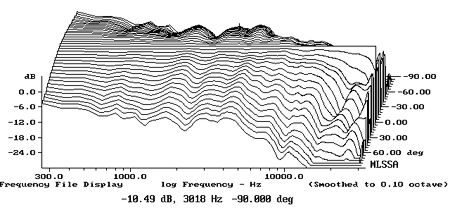
Fig.7 Rockport Merak II, lateral response family at 50", normalized to response on tweeter axis, from back to front: differences in response 90 degrees-5 degrees off-axis, reference response, differences in response 5 degrees-90 degrees off-axis.
In the vertical plane (fig.8), the Merak maintains its even balance over quite a wide window—which is just as well, given the 42" height of its tweeter from the floor when it sits on the Sheritan. Slouch in a low chair or stand up, and a suckout will develop in the crossover region.

Fig.8 Rockport Merak II, vertical response family at 50", normalized to response on tweeter axis, from back to front: differences in response 20 degrees-5 degrees above axis, reference response, differences in response 5 degrees-15 degrees below axis.
The Merak's step response (fig.9) indicates that both its drive-units are connected with the same, positive acoustic polarity, as is the Sheritan's woofer (not shown). Despite the Merak's sloped-back baffle, the speaker's output can be seen not to be time-coincident; however, the tweeter step smoothly hands over to that of the woofer, confirming the excellent frequency-domain integration between the two units shown earlier. The Rockport's cumulative spectral-decay, or waterfall, plot (fig.10) is about as good as it gets—this is a great tweeter—with only some delayed energy associated with the woofer's on-axis peak evident.

Fig.9 Rockport Merak II, step response on tweeter axis at 50" (5ms time window, 30kHz bandwidth).

Fig.10 Rockport Merak II, cumulative spectral-decay plot at 50" (0.15ms risetime).
Overall, this is excellent measured performance.—John Atkinson
- Log in or register to post comments




































